Abstract
1. Previous studies have shown that the mixed A1/A2 adenosine agonist 5'-N-ethylcarboxamido-adenosine (NECA) inhibits intestinal fluid secretion which is thought to contribute to its antidiarrhoeal effect in the rat. The aim of this study was to characterize the adenosine receptor mediating this antisecretory effect via functional studies using a range of selective agonists and antagonists and by applying the pharmacological criteria of relative agonist and antagonist potencies. 2. Adenosine agonists and antagonists were administered i.v. to anaesthetized rats. Intestinal secretion was then stimulated by i.a. infusion of vasoactive intestinal peptide (VIP, 0.8 microgram min-1) and the net fluid transport across the wall of the jejunum was measured by a recirculation technique. 3. The rank order of agonist potency to reduce the response to VIP was: NECA > N6-cyclopentyladenosine (CPA) > R-N6-(2-phenylisopropyladenosine) (R-PIA) > S-PIA > chloroadenosine (2-CADO) > 2-phenylaminoadenosine (CV-1808). This order best complies with the rank order of agonist potency that represents activation of the recently described A2B receptor: NECA > 2-CADO > R-PIA = CHA > S-PIA > = CV-1808 > = CGS-21680. The most potent agonists (NECA, CPA and RPIA) had ED50 values in the low microgram range. 4. The anitsecretory action of NECA (submaximal dose of 40 micrograms kg-1) was antagonized equally (approximately 50%) by the selective adenosine antagonists 8-cyclopentyl-1,3-dipropylxanthine (DPCPX, 0.1 mg kg-1) and 8-phenyltheophylline (8-PT, 0.1 mg kg-1). This equipotent activity indicates the presence of an A2 and not an A1 receptor.(ABSTRACT TRUNCATED AT 250 WORDS)
Full text
PDF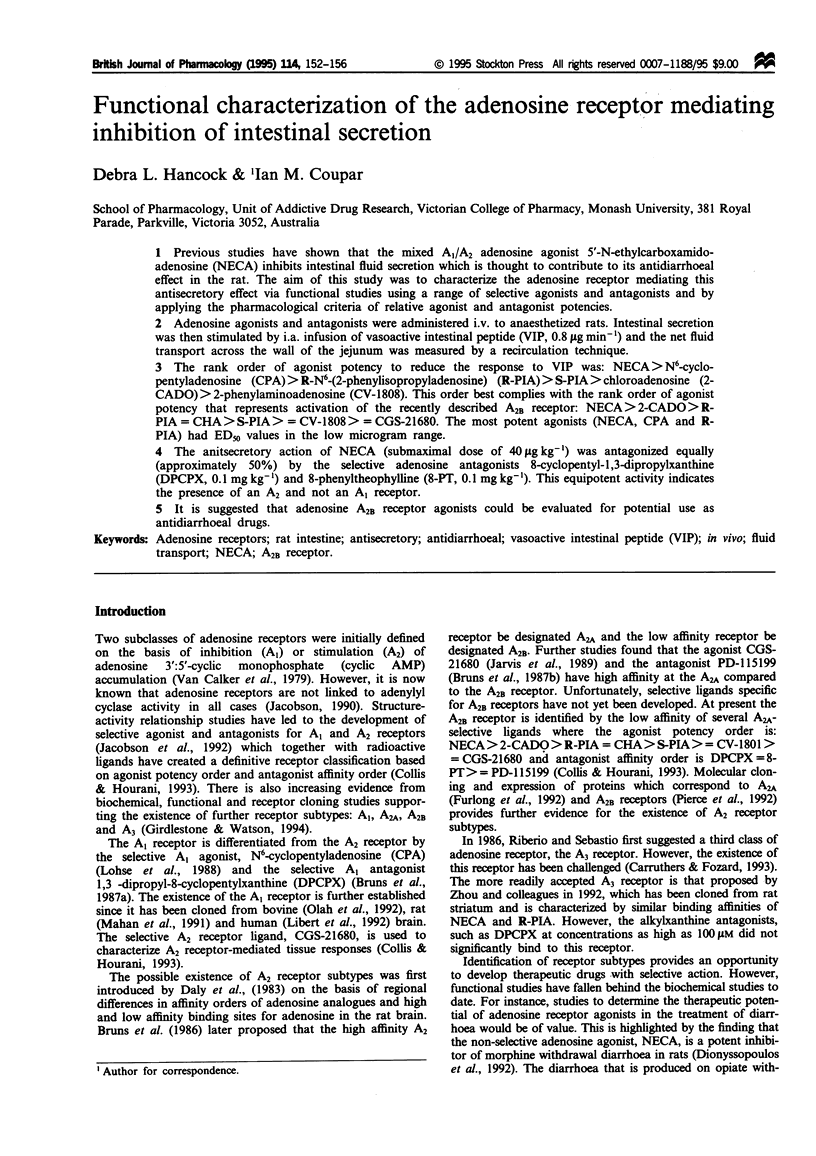
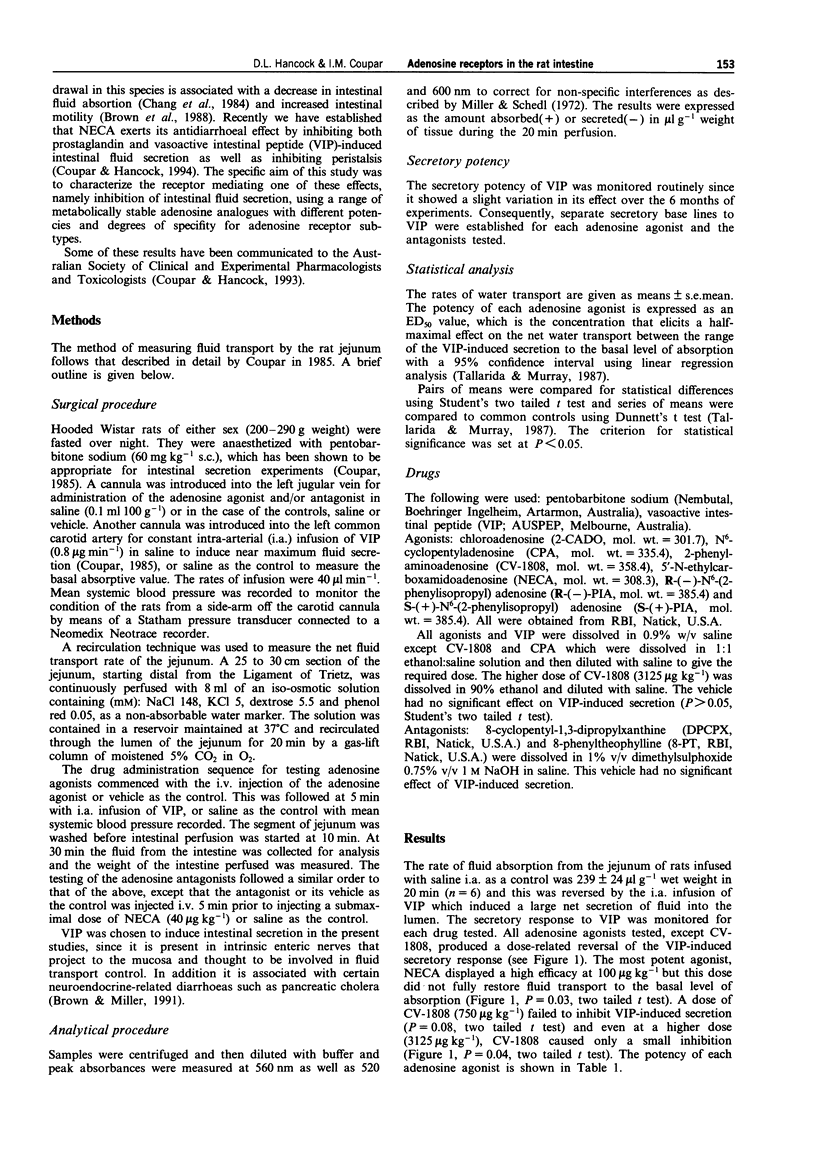
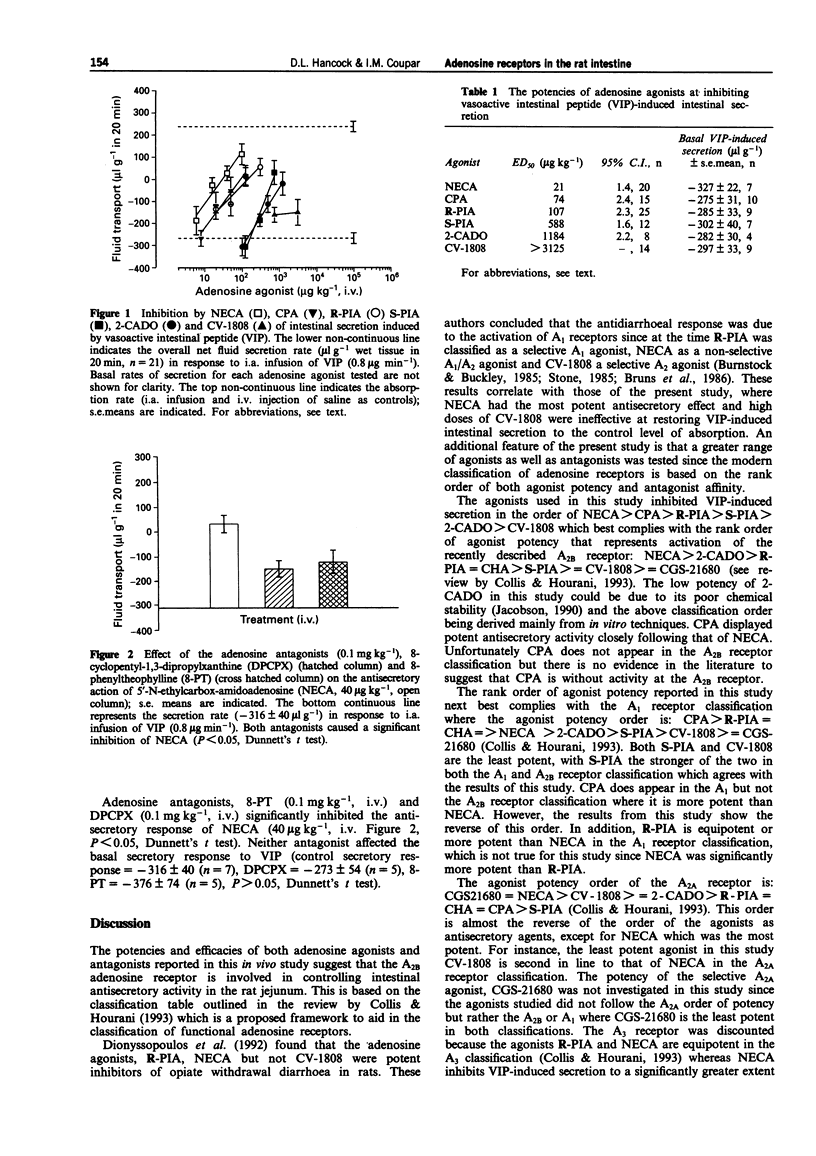
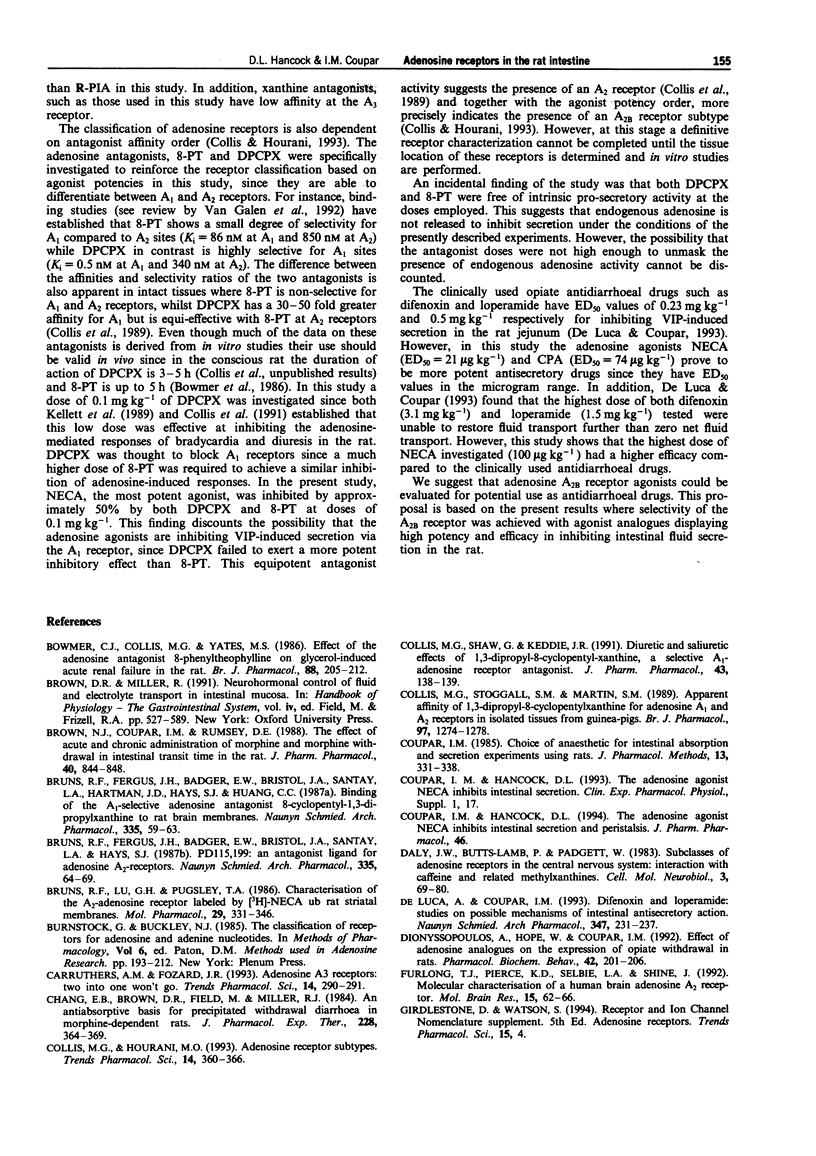
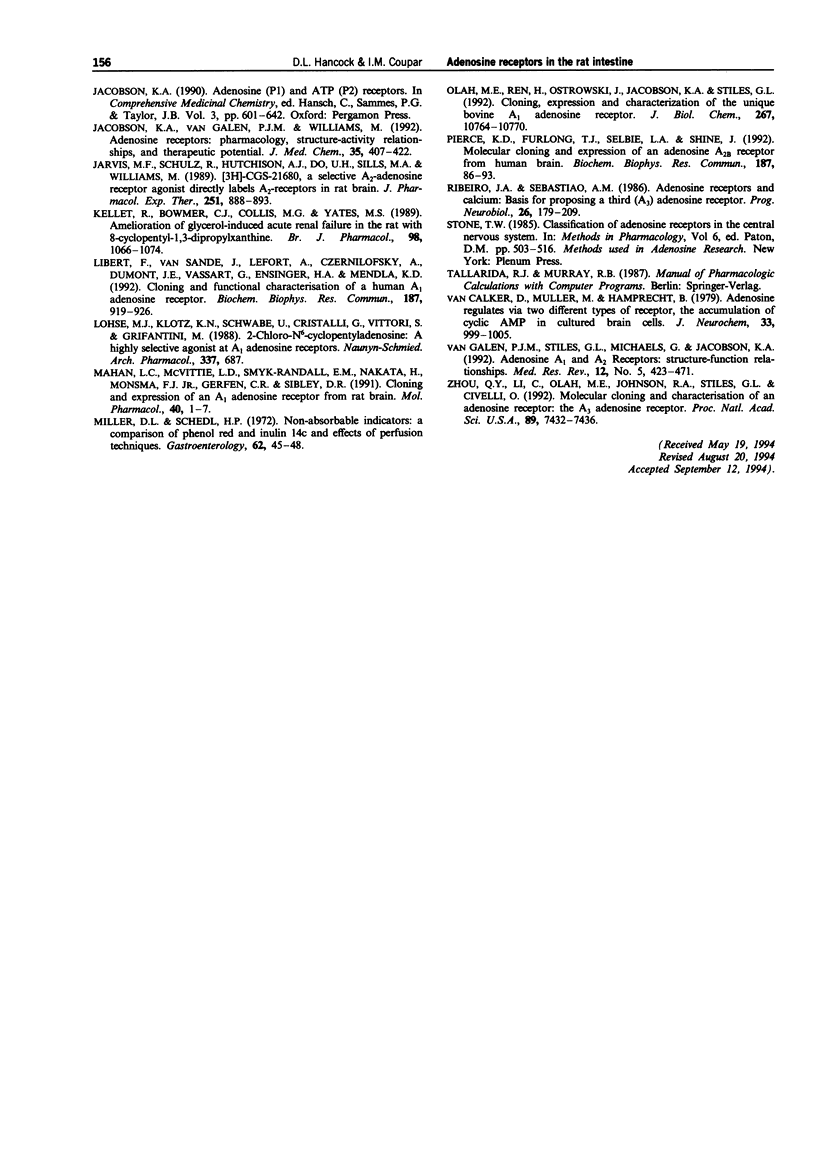
Selected References
These references are in PubMed. This may not be the complete list of references from this article.
- Bowmer C. J., Collis M. G., Yates M. S. Effect of the adenosine antagonist 8-phenyltheophylline on glycerol-induced acute renal failure in the rat. Br J Pharmacol. 1986 May;88(1):205–212. doi: 10.1111/j.1476-5381.1986.tb09488.x. [DOI] [PMC free article] [PubMed] [Google Scholar]
- Brown N. J., Coupar I. M., Rumsey R. D. The effect of acute and chronic administration of morphine and morphine withdrawal on intestinal transit time in the rat. J Pharm Pharmacol. 1988 Dec;40(12):844–848. doi: 10.1111/j.2042-7158.1988.tb06286.x. [DOI] [PubMed] [Google Scholar]
- Bruns R. F., Fergus J. H., Badger E. W., Bristol J. A., Santay L. A., Hartman J. D., Hays S. J., Huang C. C. Binding of the A1-selective adenosine antagonist 8-cyclopentyl-1,3-dipropylxanthine to rat brain membranes. Naunyn Schmiedebergs Arch Pharmacol. 1987 Jan;335(1):59–63. doi: 10.1007/BF00165037. [DOI] [PubMed] [Google Scholar]
- Bruns R. F., Fergus J. H., Badger E. W., Bristol J. A., Santay L. A., Hays S. J. PD 115,199: an antagonist ligand for adenosine A2 receptors. Naunyn Schmiedebergs Arch Pharmacol. 1987 Jan;335(1):64–69. doi: 10.1007/BF00165038. [DOI] [PubMed] [Google Scholar]
- Bruns R. F., Lu G. H., Pugsley T. A. Characterization of the A2 adenosine receptor labeled by [3H]NECA in rat striatal membranes. Mol Pharmacol. 1986 Apr;29(4):331–346. [PubMed] [Google Scholar]
- Carruthers A. M., Fozard J. R. Adenosine A3 receptors: two into one won't go. Trends Pharmacol Sci. 1993 Aug;14(8):290–291. doi: 10.1016/0165-6147(93)90042-I. [DOI] [PubMed] [Google Scholar]
- Chang E. B., Brown D. R., Field M., Miller R. J. An antiabsorptive basis for precipitated withdrawal diarrhea in morphine-dependent rats. J Pharmacol Exp Ther. 1984 Feb;228(2):364–369. [PubMed] [Google Scholar]
- Collis M. G., Hourani S. M. Adenosine receptor subtypes. Trends Pharmacol Sci. 1993 Oct;14(10):360–366. doi: 10.1016/0165-6147(93)90094-z. [DOI] [PubMed] [Google Scholar]
- Collis M. G., Shaw G., Keddie J. R. Diuretic and saliuretic effects of 1,3-dipropyl-8-cyclopentylxanthine, a selective A1-adenosine receptor antagonist. J Pharm Pharmacol. 1991 Feb;43(2):138–139. doi: 10.1111/j.2042-7158.1991.tb06651.x. [DOI] [PubMed] [Google Scholar]
- Collis M. G., Stoggall S. M., Martin F. M. Apparent affinity of 1,3-dipropyl-8-cyclopentylxanthine for adenosine A1 and A2 receptors in isolated tissues from guinea-pigs. Br J Pharmacol. 1989 Aug;97(4):1274–1278. doi: 10.1111/j.1476-5381.1989.tb12589.x. [DOI] [PMC free article] [PubMed] [Google Scholar]
- Coupar I. M. Choice of anesthetic for intestinal absorption and secretion experiments using rats. J Pharmacol Methods. 1985 Jul;13(4):331–338. doi: 10.1016/0160-5402(85)90015-4. [DOI] [PubMed] [Google Scholar]
- Daly J. W., Butts-Lamb P., Padgett W. Subclasses of adenosine receptors in the central nervous system: interaction with caffeine and related methylxanthines. Cell Mol Neurobiol. 1983 Mar;3(1):69–80. doi: 10.1007/BF00734999. [DOI] [PMC free article] [PubMed] [Google Scholar]
- De Luca A., Coupar I. M. Difenoxin and loperamide: studies on possible mechanisms of intestinal antisecretory action. Naunyn Schmiedebergs Arch Pharmacol. 1993 Feb;347(2):231–237. doi: 10.1007/BF00169273. [DOI] [PubMed] [Google Scholar]
- Dionyssopoulos T., Hope W., Coupar I. M. Effect of adenosine analogues on the expression of opiate withdrawal in rats. Pharmacol Biochem Behav. 1992 Jun;42(2):201–206. doi: 10.1016/0091-3057(92)90516-i. [DOI] [PubMed] [Google Scholar]
- Furlong T. J., Pierce K. D., Selbie L. A., Shine J. Molecular characterization of a human brain adenosine A2 receptor. Brain Res Mol Brain Res. 1992 Sep;15(1-2):62–66. doi: 10.1016/0169-328x(92)90152-2. [DOI] [PubMed] [Google Scholar]
- Jacobson K. A., van Galen P. J., Williams M. Adenosine receptors: pharmacology, structure-activity relationships, and therapeutic potential. J Med Chem. 1992 Feb 7;35(3):407–422. doi: 10.1021/jm00081a001. [DOI] [PMC free article] [PubMed] [Google Scholar]
- Jarvis M. F., Schulz R., Hutchison A. J., Do U. H., Sills M. A., Williams M. [3H]CGS 21680, a selective A2 adenosine receptor agonist directly labels A2 receptors in rat brain. J Pharmacol Exp Ther. 1989 Dec;251(3):888–893. [PubMed] [Google Scholar]
- Kellett R., Bowmer C. J., Collis M. G., Yates M. S. Amelioration of glycerol-induced acute renal failure in the rat with 8-cyclopentyl-1,3-dipropylxanthine. Br J Pharmacol. 1989 Nov;98(3):1066–1074. doi: 10.1111/j.1476-5381.1989.tb14639.x. [DOI] [PMC free article] [PubMed] [Google Scholar]
- Libert F., Van Sande J., Lefort A., Czernilofsky A., Dumont J. E., Vassart G., Ensinger H. A., Mendla K. D. Cloning and functional characterization of a human A1 adenosine receptor. Biochem Biophys Res Commun. 1992 Sep 16;187(2):919–926. doi: 10.1016/0006-291x(92)91285-x. [DOI] [PubMed] [Google Scholar]
- Lohse M. J., Klotz K. N., Schwabe U., Cristalli G., Vittori S., Grifantini M. 2-Chloro-N6-cyclopentyladenosine: a highly selective agonist at A1 adenosine receptors. Naunyn Schmiedebergs Arch Pharmacol. 1988 Jun;337(6):687–689. doi: 10.1007/BF00175797. [DOI] [PubMed] [Google Scholar]
- Mahan L. C., McVittie L. D., Smyk-Randall E. M., Nakata H., Monsma F. J., Jr, Gerfen C. R., Sibley D. R. Cloning and expression of an A1 adenosine receptor from rat brain. Mol Pharmacol. 1991 Jul;40(1):1–7. [PubMed] [Google Scholar]
- Miller D. L., Schedl H. P. Nonabsorbed indicators: a comparison of phenol red and inulin- 14 C and effects of perfusion technique. Gastroenterology. 1972 Jan;62(1):48–55. [PubMed] [Google Scholar]
- Olah M. E., Ren H., Ostrowski J., Jacobson K. A., Stiles G. L. Cloning, expression, and characterization of the unique bovine A1 adenosine receptor. Studies on the ligand binding site by site-directed mutagenesis. J Biol Chem. 1992 May 25;267(15):10764–10770. [PMC free article] [PubMed] [Google Scholar]
- Pierce K. D., Furlong T. J., Selbie L. A., Shine J. Molecular cloning and expression of an adenosine A2b receptor from human brain. Biochem Biophys Res Commun. 1992 Aug 31;187(1):86–93. doi: 10.1016/s0006-291x(05)81462-7. [DOI] [PubMed] [Google Scholar]
- Ribeiro J. A., Sebastião A. M. Adenosine receptors and calcium: basis for proposing a third (A3) adenosine receptor. Prog Neurobiol. 1986;26(3):179–209. doi: 10.1016/0301-0082(86)90015-8. [DOI] [PubMed] [Google Scholar]
- Zhou Q. Y., Li C., Olah M. E., Johnson R. A., Stiles G. L., Civelli O. Molecular cloning and characterization of an adenosine receptor: the A3 adenosine receptor. Proc Natl Acad Sci U S A. 1992 Aug 15;89(16):7432–7436. doi: 10.1073/pnas.89.16.7432. [DOI] [PMC free article] [PubMed] [Google Scholar]
- van Calker D., Müller M., Hamprecht B. Adenosine regulates via two different types of receptors, the accumulation of cyclic AMP in cultured brain cells. J Neurochem. 1979 Nov;33(5):999–1005. doi: 10.1111/j.1471-4159.1979.tb05236.x. [DOI] [PubMed] [Google Scholar]
- van Galen P. J., Stiles G. L., Michaels G., Jacobson K. A. Adenosine A1 and A2 receptors: structure--function relationships. Med Res Rev. 1992 Sep;12(5):423–471. doi: 10.1002/med.2610120502. [DOI] [PMC free article] [PubMed] [Google Scholar]


